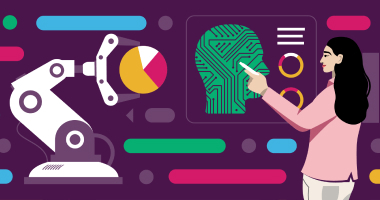Every month, more than 100 million travelers in 52 countries turn to the Edinburgh-founded company Skyscanner to search for and book the best flights, hotels and car rentals. For questions and issues with the Skyscanner website and app, support is just a tap away—and behind the scenes, engineers help troubleshoot issues.
These support engineers are part of an “employee and engineering enablement” strategy led by Skyscanner principal systems engineer John Paris. His team is responsible for the underlying production platform and tools that Skyscanner’s engineers use to serve those millions of travelers. “We support the teams that keep our company running,” he says.
As part of its culture of open communication and enablement, Skyscanner traded email for Slack in 2014. “Slack changed the organization overnight: It went from a proof of concept to something we couldn’t live without,” Paris says. “Everything happens in Slack. From product decisions and all-hands announcements down to people organizing lunch, it’s part of the fabric of Skyscanner.”
On Paris’s team, the implementation of Nextup.ai HelpDesk+ for Jira Service Management in Slack was especially crucial, dramatically improving engineers’ ability to track and resolve issues.
Nextup.ai HelpDesk+ in Slack simplifies Skyscanner’s support workflows by:
- Automatically creating support tickets when users message in Slack
- Converting conversations to trackable tickets
- Archiving support requests to create a searchable source of knowledge

“Slack changed the organization overnight: It went from a proof of concept to something we couldn’t live without. Everything happens in Slack.”
Using automation and data to empower engineers
The natural place to manage engineering support, Slack fit in well with Skyscanner’s vision of open and transparent communication. But engineers lost precious time switching to a support portal to track requests, and a lack of visibility into the tickets pipeline slowed them down: 50% of cases took more than two days to resolve.
“We were actually losing 20% of our cases,” Paris says. “That meant our internal customers gave up and disappeared before getting responses.”
Engineers also wanted to view their support performance from a high level, tapping into data that showed how efficiently requests were handled over time. Skyscanner didn’t have such data, and without it, Paris says, “we could only make guesses about customer needs.”
When Paris and his colleagues tallied up their priorities—automated support within Slack, no new skills to learn, a queue system, and tracking and data collection—HelpDesk+ from Nextup.ai rose to the top of the support solution list. “The simplicity of HelpDesk+ in Slack met all our requirements,” he says.
“Seeing the HelpDesk+ conversations in our Slack channels is so important. People constantly contribute to the conversation and chip in their ideas.”
Sharing solutions to resolve problems faster
Using HelpDesk+ in Slack, engineers can track support requests to ensure follow-through, measure workload and support performance, and archive requests to leverage knowledge later. All support requests originate in Slack, eliminating the need for engineers to monitor and respond to separate solutions.

The support process now has a queue system in HelpDesk+ to sequence requests and provide automated feedback to users. Engineers can turn Slack conversations into new support tickets, or attach the conversations to existing requests.
Best of all, everything happens in Slack, and any engineer can jump in to help a colleague. “Seeing the HelpDesk+ conversations in our Slack channels is so important,” Paris says. “People constantly contribute to the conversation and chip in their ideas.”
Solving triple the support requests with a smaller team
Since engineers began using HelpDesk+ in Slack, response times have dropped from as long as two days to as little as two hours. Three times as many tickets are logged, from 160 a month prior to the HelpDesk+ integration to more than 500 a month today.

The results are all the more impressive considering that Skyscanner’s enablement team was able to deliver faster, more efficient outcomes, with less people needed to do so. “We’re able to keep up with requests and deliver better service with Slack,” Paris says.
There’s also the positive outcome that can’t be tracked with metrics but that Paris believes is essential to maintaining a happy and energized team. “There’s a greater feeling of well-being among the enablement engineers,” he says. “Especially for those who like to be organized and feel good about what they’ve achieved, HelpDesk+ has been a huge benefit.”




